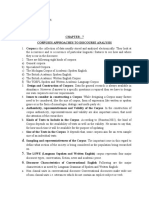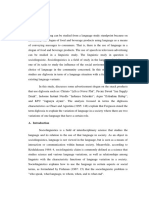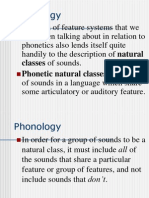100%(1)100% found this document useful (1 vote)
144 viewsIntroduction To Sociolinguistics: Chapter One: Overview: What Is Sociolinguistics? What Do Sociolinguists Study?
Introduction To Sociolinguistics: Chapter One: Overview: What Is Sociolinguistics? What Do Sociolinguists Study?
Uploaded by
ANDI ASRIFANThis document provides an introduction and overview of the field of sociolinguistics. It defines sociolinguistics as the study of the relationship between language and society, looking at how people use language in different social contexts. It discusses some of the major figures who influenced the field, such as Chomsky, Hymes, and Saussure. Finally, it outlines some of the major topics of research within sociolinguistics, such as dialects, styles of speech, bilingualism, language and identity, and the relationship between language and power structures in society.
Copyright:
© All Rights Reserved
Available Formats
Download as PPT, PDF, TXT or read online from Scribd
Introduction To Sociolinguistics: Chapter One: Overview: What Is Sociolinguistics? What Do Sociolinguists Study?
Introduction To Sociolinguistics: Chapter One: Overview: What Is Sociolinguistics? What Do Sociolinguists Study?
Uploaded by
ANDI ASRIFAN100%(1)100% found this document useful (1 vote)
144 views18 pagesThis document provides an introduction and overview of the field of sociolinguistics. It defines sociolinguistics as the study of the relationship between language and society, looking at how people use language in different social contexts. It discusses some of the major figures who influenced the field, such as Chomsky, Hymes, and Saussure. Finally, it outlines some of the major topics of research within sociolinguistics, such as dialects, styles of speech, bilingualism, language and identity, and the relationship between language and power structures in society.
Original Description:
Sociolinguistics
Original Title
Intro Sociolinguistics
Copyright
© © All Rights Reserved
Available Formats
PPT, PDF, TXT or read online from Scribd
Share this document
Did you find this document useful?
Is this content inappropriate?
This document provides an introduction and overview of the field of sociolinguistics. It defines sociolinguistics as the study of the relationship between language and society, looking at how people use language in different social contexts. It discusses some of the major figures who influenced the field, such as Chomsky, Hymes, and Saussure. Finally, it outlines some of the major topics of research within sociolinguistics, such as dialects, styles of speech, bilingualism, language and identity, and the relationship between language and power structures in society.
Copyright:
© All Rights Reserved
Available Formats
Download as PPT, PDF, TXT or read online from Scribd
Download as ppt, pdf, or txt
100%(1)100% found this document useful (1 vote)
144 views18 pagesIntroduction To Sociolinguistics: Chapter One: Overview: What Is Sociolinguistics? What Do Sociolinguists Study?
Introduction To Sociolinguistics: Chapter One: Overview: What Is Sociolinguistics? What Do Sociolinguists Study?
Uploaded by
ANDI ASRIFANThis document provides an introduction and overview of the field of sociolinguistics. It defines sociolinguistics as the study of the relationship between language and society, looking at how people use language in different social contexts. It discusses some of the major figures who influenced the field, such as Chomsky, Hymes, and Saussure. Finally, it outlines some of the major topics of research within sociolinguistics, such as dialects, styles of speech, bilingualism, language and identity, and the relationship between language and power structures in society.
Copyright:
© All Rights Reserved
Available Formats
Download as PPT, PDF, TXT or read online from Scribd
Download as ppt, pdf, or txt
You are on page 1of 18
Introduction to
Sociolinguistics
Chapter One: Overview: What is
sociolinguistics?
What do sociolinguists study?
Defining sociolinguistics
Sociolinguistics is the study of
the complex relationship
between language and society
It is concerned with describing
how people use language in
social contexts
It is based on ‘real-life’ data of
language use
Research in sociolinguistics
often tries to address social
problems such as
miscommunication, bias,
oppression, success and
failure, effectiveness, conflicts,
professional training.
No single or dominant ‘theory’ or method of
analysis in sociolinguistics: diverse and eclectic
field
Broad field of study, looking at language-in-use,
based on analyses of naturally-occurring, ‘real-
life’ empirical data materials (recordings,
surveys, questionnaires, etc.)
Defining sociolinguistics
Sociolinguistics and the sociology of language
(see Hudson, p. 12)
Macro- and micro-sociolinguistics (see
Coulmas, p. 13)
Wardhaugh’s position on the relationship (p. 13)
Discussion p. 15, esp 1, 2, 4, 5 and 6
Relation between language and
society
‘Society’: a fuzzy notion in
sociolinguistics.
It can mean ‘the national group’ (i.e.
the conventional definition), but can
also be more loosely defined as
‘community’, ‘group’ or ‘network’.
This collectivity may vary in size and
be formed by such things as age,
interest, family, gender, ethnicity,
occupation, geography, social
position, etc.
‘language’ and ‘society’
connections ...
Several possible connections, or relationships:
1. Social structure (e.g., age, region, education, class,
religion, occupation) determines linguistic structure
2. Linguistic structure (a specific language) determines
social structure (this is known as ‘The Sapir-Whorf
Hypothesis’)
3. Dialectical relationship between ‘language’ and ‘society’:
state of flux
4. No relationship (e.g. Chomskian view) worth studying
Knowledge of language use
A major theme in sociolinguistics is
being able to discover, and describe,
what it entails to use and understand
language appropriately - within the
group
Appropriacy is centrally concerned
with the choices the people make: of
codes, topics, turn-taking styles,
‘registers’, jargon, politeness markers,
swear words, etc. (Holmes, p. 11)
Cultural knowledge
Cultural knowledge is therefore all-important
Cultural knowledge entails knowing how groups (family,
friends, colleagues, fellow citizens, etc.) behave (or are
likely to behave), what is ‘normal’ (and ‘abnormal’)
behaviour (remember that using language is a form of
behaviour!), what is ‘expected’ in a multiplicity of social
settings.
Norms, values, attitudes (which are all cultural
products and thus culturally constructed in
different communities) are reflexively related to
language; that is, they are all displayed through
language, but also sustained, or changed,
challenged and modified through language.
These are dynamic and collectively defined
Discussion, p. 12
Noam Chomsky
One of the most influential
linguists of the 20th century
Interested in grammaticality:
how humans use a finite set of
structures and rules to produce
an infinite number of
grammatically correct
sentences
We are ‘hard wired’ to learn
abstract ‘deep structures’; this
ability is innate to humans
Chomsky
Knowledge of language: ‘competence’ and ‘performance’
But linguistics should concern itself with the former, rather than
the latter, argued Chomsky (see p. 3)
Study of linguistics should focus on ‘Ideal speaker-listener,
homogeneous speech community, possessing perfect
knowledge of language’
Dell Hymes: Challenges Chomsky
ideas on language ..
Dissatisfied with Chomsky’s
definition of ‘competence’: too
narrow, too abstract, too sterile,
and most importantly: too asocial
Hymes broadened the
‘competence’ notion to include
knowledge of appropriate
language use in the social and
cultural context (i.e. not only
syntactic correctness, which
Chomsky emphasized)
Hymes’ views (cont’d)
Knowing a language: not only grammar but also
knowing about use in contexts, hence ‘communicative
competence’ (major influence on foreign language
teaching in 1970’s and 1980s)
Hymes: We need to merge ethnography (the study of
humans in social and cultural groups) and linguistics
(the study of language), to produce an ‘ethnography of
speaking’ - the forerunner of sociolinguistics
A good deal of sociolinguistic research has adopted
Hymes’ ‘ethnography of speaking’ approach
Ferdinand de Saussure (1857-
1913)
Chomsky’s competence-
performance distinction was
taken from Ferdinand de
Saussure’s distinction between
langue (group knowledge) and
parole (individual knowledge)
de Saussure: “the father of
modern linguistics”, saw the study
of language in new ways
Language is organic, (not
atomistic) and should be studied
as such
Diachronic and synchronic
Paradigmatic and syntagmatic
Major topics in sociolinguistic
research (since the mid 1960’s)
Like linguistics, sociolinguistics is a broad and eclectic field:
Although sociolinguists are united by their interest in the social use
of language, their fundamental belief in empirical data collections,
and insist on focusing on how people USE language in the social
contexts
there is nevertheless no single dominant analytic method or
‘theory’, no specific ‘goal’ or ‘leader’ figure in the field, no one
dominant research topic
There is a cluster of major topics. These include:
Dialects and regional variation: What? Where? Why? Social
significance?
Describing styles of talking (amongst certain groups in various
contexts): informal, friendly chat, job interviews, doctor-patient
consultations, teaching, etc.
Bilingualism and multilingualism: How learned? How used? Social
meaning of using more than one language?
Networks and language use within the network: How are new
members acculturated, sanctioned, what are the rules of the
network, etc.
Major research areas, continued
Culture and language: how the two interrelate, and why (Sapir-Whorf
Hypothesis)
Intercultural communication: problems and solutions
Politeness: How? Mapping and explaining gradations of politeness
Child language, sub-group discourse (elderly, teenagers, hiphoppers,
truckers, gays, etc.)
Language and identity (how identity is accomplished via language)
Talk and conversation - how talk ‘works’: topics, beginnings, turns, ends ..
Gender and language - men and women interacting: differences?
Racism, sexism, ageism, and disadvantage - how language plays a role,
and how it can alleviate problems
Language planning - for educators, teacher trainers, schools, nation states,
regions, etc (What should be taught and what not? How? Why?)
Principles for sociolinguistic
investigation (p. 18)
The cumulative principle
The uniformation principle
Principle of convergence
Subordinate shift
Styleshifting
Attention
Vernacular
Formality
You might also like
- Theories of Scientific Method - An Introduction (Philosophy and Science) PDFDocument392 pagesTheories of Scientific Method - An Introduction (Philosophy and Science) PDFRey Borbor83% (6)
- Deleuze's NietzscheDocument19 pagesDeleuze's NietzscheThomas Ruble100% (2)
- Sociolinguistics Lecture 1Document6 pagesSociolinguistics Lecture 1Samah Sam Bouima100% (2)
- Sociolinguistics Mid TermDocument49 pagesSociolinguistics Mid TermUmmama Bhutta100% (1)
- Sociolinguistics: "Society On Language" "Language Effects On Society"Document3 pagesSociolinguistics: "Society On Language" "Language Effects On Society"Bonjovi HajanNo ratings yet
- Communicative Competence: Linguistic Competence, Socio-Linguistic Competence, Discourse CompetenceDocument10 pagesCommunicative Competence: Linguistic Competence, Socio-Linguistic Competence, Discourse Competencedenisa firoiu100% (1)
- Summary DiscourseDocument8 pagesSummary DiscourseDevi Selfiani Sabri100% (1)
- LinguisticsDocument14 pagesLinguisticsGlennmeloveNo ratings yet
- An Introduction To Applied LinguisticsDocument30 pagesAn Introduction To Applied Linguisticspriya avaisNo ratings yet
- Introduction: Basic Concepts: Course: PsycholinguisticsDocument17 pagesIntroduction: Basic Concepts: Course: PsycholinguisticsSADIA SHANNo ratings yet
- Ethnography of SpeakingDocument22 pagesEthnography of SpeakingButchNo ratings yet
- Language Choice (s1)Document12 pagesLanguage Choice (s1)Bagas TiranggaNo ratings yet
- Language Attrition Monika S. Schmid and Kees de Bot: April 15, 2018 Marnelie B. Blances ReporterDocument38 pagesLanguage Attrition Monika S. Schmid and Kees de Bot: April 15, 2018 Marnelie B. Blances ReporterMarnelie Buenaflor BlancesNo ratings yet
- Communicative CompetenceDocument2 pagesCommunicative CompetenceLevente Jambrik0% (1)
- Discourse Analysis and Second Language Writing - Wennerstrom Chap 01Document16 pagesDiscourse Analysis and Second Language Writing - Wennerstrom Chap 01MohamshabanNo ratings yet
- Sociolinguistics Assignment QuestionsDocument5 pagesSociolinguistics Assignment QuestionsMarema ReginaldoNo ratings yet
- Module 3 - Speech Arts Overview Part 2Document31 pagesModule 3 - Speech Arts Overview Part 2jeo nalugon100% (1)
- Applied LingDocument11 pagesApplied Lingحسام جدوNo ratings yet
- Course OutlineDocument2 pagesCourse OutlinerabiaNo ratings yet
- Discourse AnalysisDocument9 pagesDiscourse AnalysisDianeNo ratings yet
- Chapter 1 - Language & SocietyDocument13 pagesChapter 1 - Language & SocietyYesicha Ryona50% (2)
- The Language System of EnglishDocument25 pagesThe Language System of EnglishTee FleNo ratings yet
- LCP Powerpoint Sapir Whorf HypothesisDocument9 pagesLCP Powerpoint Sapir Whorf HypothesisKatieOcampoNo ratings yet
- Literature Review On Code Switching and Code MixingDocument6 pagesLiterature Review On Code Switching and Code MixingafmzfxfaalkjcjNo ratings yet
- Wardhaugh CH 3Document10 pagesWardhaugh CH 3Mubashir WaqarNo ratings yet
- On Style, Stylistics and TranslationDocument22 pagesOn Style, Stylistics and TranslationElena PetcuNo ratings yet
- Speech CommunityDocument22 pagesSpeech CommunityURS-Roxas, Elisa, O.100% (2)
- Language and PowerDocument21 pagesLanguage and PowerLynette ChangNo ratings yet
- Pidgins and CreoleDocument15 pagesPidgins and CreoleRizky Eka PrasetyaNo ratings yet
- Wardhaugh Chapter 4Document2 pagesWardhaugh Chapter 4Jude0% (1)
- Sociolinguistics and Language Teaching HandoutDocument22 pagesSociolinguistics and Language Teaching HandoutSri RejekiNo ratings yet
- The Use of Slang Amongst Undergraduate Students of A Malaysian Public UniversityDocument9 pagesThe Use of Slang Amongst Undergraduate Students of A Malaysian Public UniversityJOURNAL OF ADVANCES IN LINGUISTICS100% (1)
- Approaches To DiscourseDocument26 pagesApproaches To Discoursenabeelajaved100% (1)
- Unit 5 - Phonology-Some Basic ConceptsDocument12 pagesUnit 5 - Phonology-Some Basic ConceptsNguyễn Hữu NguyênNo ratings yet
- Ethnicity and Language UseDocument19 pagesEthnicity and Language Useanna39No ratings yet
- SociolinguisticsWardhaugh CH 13Document17 pagesSociolinguisticsWardhaugh CH 13loviebabe100% (1)
- Dialect Continuum: By: Anuja Gaikwad (EE) 1904110Document9 pagesDialect Continuum: By: Anuja Gaikwad (EE) 1904110ANUJA GAIKWADNo ratings yet
- Branches of LinguisticsDocument7 pagesBranches of LinguisticsMeer Murtaza GopangNo ratings yet
- Communicative Competence Dell Hymes PDFDocument2 pagesCommunicative Competence Dell Hymes PDFKelly0% (3)
- Genre AnalysisDocument19 pagesGenre AnalysisTHE PROFESSORS'100% (1)
- 1Document9 pages1sumayya tariqNo ratings yet
- Forensic Linguistics: IntroductionDocument3 pagesForensic Linguistics: IntroductionKhadija SaeedNo ratings yet
- DiglossiaDocument9 pagesDiglossiaWardani Dwi WNo ratings yet
- Principles and Purpose of Language AssessmentDocument12 pagesPrinciples and Purpose of Language AssessmentalabangcollegeNo ratings yet
- Guy Cook's Applied Linguistics: Chapter 3: Languages in The Contemporary World Dina BensureitiDocument29 pagesGuy Cook's Applied Linguistics: Chapter 3: Languages in The Contemporary World Dina BensureitiDina Bensreti100% (1)
- PsycholinguisticsDocument24 pagesPsycholinguisticsMasum RahmanNo ratings yet
- Socioling Exam PDFDocument3 pagesSocioling Exam PDFcielo curyNo ratings yet
- The Idea of Feature Systems That We Have Been Talking About in Relation To Phonetics Also Lends Itself Quite Handily To The Description of NaturalDocument59 pagesThe Idea of Feature Systems That We Have Been Talking About in Relation To Phonetics Also Lends Itself Quite Handily To The Description of NaturalhiooNo ratings yet
- Sociolinguistics (Essay)Document6 pagesSociolinguistics (Essay)Youniverse0% (1)
- Ch. 1 Summary (HOLMES)Document4 pagesCh. 1 Summary (HOLMES)Carol SalmanNo ratings yet
- تاشير أمتحان نهائيDocument30 pagesتاشير أمتحان نهائيanmar ahmedNo ratings yet
- Semantic Analysis of English Verbs in Reuters World Tweets: Mustansiriyah UniversityDocument6 pagesSemantic Analysis of English Verbs in Reuters World Tweets: Mustansiriyah UniversityAumnia Jamal0% (1)
- Sociolinguistics Is The Study of The Effect of Any and All Aspects of SocietyDocument8 pagesSociolinguistics Is The Study of The Effect of Any and All Aspects of SocietyDedi SetiadiNo ratings yet
- Linguistics Micro & Macro Levels PDFDocument22 pagesLinguistics Micro & Macro Levels PDFMà Ř YãmNo ratings yet
- Kers Will 2004 Social Dialect Ology PDFDocument20 pagesKers Will 2004 Social Dialect Ology PDFNajla BA50% (2)
- 2-Is Linguistics A ScienceDocument14 pages2-Is Linguistics A Sciencealex darudeNo ratings yet
- A Course in Applied Linguistics: For Language Sciences and TEFL MasterDocument42 pagesA Course in Applied Linguistics: For Language Sciences and TEFL Masterkmikhlafi100% (3)
- First Language AcquisitionDocument21 pagesFirst Language AcquisitionKeith Wheeler100% (1)
- 1 Stylistics (2) Master 2Document47 pages1 Stylistics (2) Master 2Safa Bzd100% (1)
- Code-Switching and Code-Mixing in Jokowi's VlogsDocument4 pagesCode-Switching and Code-Mixing in Jokowi's VlogsYalma Rifqiya Mauludini100% (1)
- Multilingual Speech CommunitiesDocument9 pagesMultilingual Speech CommunitiesAris PetNo ratings yet
- The Acquisition of Sociolinguistic Competence in a Lingua Franca ContextFrom EverandThe Acquisition of Sociolinguistic Competence in a Lingua Franca ContextNo ratings yet
- Estranged Labor by Karl MarxDocument3 pagesEstranged Labor by Karl MarxOliver KimNo ratings yet
- Ralf DahrendorfDocument13 pagesRalf DahrendorfMamathaNo ratings yet
- Logic: Prepared By: Ruzanna Abdul ShukorDocument42 pagesLogic: Prepared By: Ruzanna Abdul ShukorSiang ElsonNo ratings yet
- Kafka Writing and The Other PDFDocument205 pagesKafka Writing and The Other PDFAbdullah ScofieldNo ratings yet
- (2001) Pollock - Logic. An Introduction To The Formal Study of ReasoningDocument157 pages(2001) Pollock - Logic. An Introduction To The Formal Study of ReasoningJoséDuarteCoimbraNo ratings yet
- Origin & Development of Sociology: Course Code: SOC101 Course Teacher: Farhana SultanaDocument20 pagesOrigin & Development of Sociology: Course Code: SOC101 Course Teacher: Farhana SultanaShadman Sakib FahimNo ratings yet
- Buddhism, Epicureanism, and StoicismDocument24 pagesBuddhism, Epicureanism, and StoicismOmbre d'OrNo ratings yet
- Intersubjectivity 1Document25 pagesIntersubjectivity 1Khriza Joy SalvadorNo ratings yet
- Hermeneutics Reception TheoryDocument10 pagesHermeneutics Reception Theorybonyta15No ratings yet
- KAROL WOJTYLA: Modes of RelationshipDocument1 pageKAROL WOJTYLA: Modes of RelationshipFrank QueeNo ratings yet
- National QuestionDocument158 pagesNational QuestionLarry StillmanNo ratings yet
- Levi Bryant, Nick Srnicek, and Graham Harman (Eds) : The Speculative Turn: Continental Materialism and RealismDocument5 pagesLevi Bryant, Nick Srnicek, and Graham Harman (Eds) : The Speculative Turn: Continental Materialism and RealismPeterPollockNo ratings yet
- Phenomenology of PracticeDocument74 pagesPhenomenology of Practicefrente amplio animalistaNo ratings yet
- Human Right Theories: Worldhistory2/chapter/natural-RightsDocument7 pagesHuman Right Theories: Worldhistory2/chapter/natural-RightsNazra NoorNo ratings yet
- BRECKMAN, Warren - Cornelius Castoriadis Contra PostmodernismDocument14 pagesBRECKMAN, Warren - Cornelius Castoriadis Contra PostmodernismGabriel VecchiettiNo ratings yet
- Romantic Poetry Definition: It Is An International and Philosophical Movement That Redefined The FundamentalDocument5 pagesRomantic Poetry Definition: It Is An International and Philosophical Movement That Redefined The Fundamentalriman100% (1)
- (18725473 - The International Journal of The Platonic Tradition) Ugo ZilioliDocument3 pages(18725473 - The International Journal of The Platonic Tradition) Ugo ZilioliPedro Souza de AlcantaraNo ratings yet
- The Structure of The Cognitive RevolutionDocument26 pagesThe Structure of The Cognitive Revolutiontomor2100% (1)
- The University of Chicago PressDocument28 pagesThe University of Chicago PressAlonso BustamanteNo ratings yet
- Ucu 111 Summary Notes Courtesy of Monsieur Jean ?Document26 pagesUcu 111 Summary Notes Courtesy of Monsieur Jean ?John MorekaNo ratings yet
- Burgess - Principles and Concepts in Information EthicsDocument19 pagesBurgess - Principles and Concepts in Information EthicsOndřej MarekNo ratings yet
- Mill's Methods: 1. The Method of AgreementDocument3 pagesMill's Methods: 1. The Method of AgreementKunwer TaibaNo ratings yet
- Saiva Tantra, Trika VijñanabhairavaDocument21 pagesSaiva Tantra, Trika Vijñanabhairavaitineo2012No ratings yet
- Dasar FilsafatDocument66 pagesDasar FilsafatDibyo WirantoNo ratings yet
- Vasubandhu's Arguments Against AtomismDocument158 pagesVasubandhu's Arguments Against AtomismAganooru Venkateswarulu100% (4)
- Comment On Arturo Escobar Lain America at A Crossroads Alternative Modernizations, Postneoliberalism or PostdesarrollismDocument7 pagesComment On Arturo Escobar Lain America at A Crossroads Alternative Modernizations, Postneoliberalism or PostdesarrollismTomás TorresNo ratings yet
- Fulltext PDFDocument755 pagesFulltext PDFScribdMadison100% (1)
- G A Cohen Rescuing Justice and EqualityDocument4 pagesG A Cohen Rescuing Justice and EqualityEduardoNo ratings yet

























































































